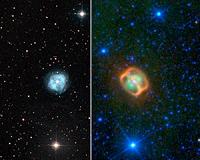 |
Somerville MA (SPX) Nov 25, 2010 Some of the universe's most massive galaxies may have formed billions of years earlier than current scientific models predict, according to surprising new research led by Tufts University. The findings appear in the Astrophysical Journal published online. "We have found a relatively large number of very massive, highly luminous galaxies that existed almost 12 billion years ago when the universe was still very young, about 1.5 billion years old. These results appear to disagree with the latest predictions from models of galaxy formation and evolution," said Tufts astrophysicist Danilo Marchesini, lead author on the paper and assistant professor of physics and astronomy at the Tufts School of Arts and Sciences. "Current understanding of the physical processes responsible in forming such massive galaxies has difficulty reproducing these observations." Collaborating with Marchesini were researchers from Yale University, Carnegie Observatories, Leiden University, Princeton University, the University of Kansas and the University of California-Santa Cruz. The newly identified galaxies were five to ten times more massive than our own Milky Way. They were among a sample studied at redshift 3=z<4, when the universe was between 1.5 and 2 billion years old. Redshift refers to the phenomenon of a light wave stretching and moving toward longer wavelengths (the red end of the spectrum) as the emitting object travels away from an observer (Doppler Effect). This is similar to the pitch of a siren getting lower as the siren moves away. The redshift of distant galaxies is due to the expansion of the universe. The larger the redshift, the more distant the galaxy is, or the farther back in time we are observing. The larger the redshift, the younger the universe in which the galaxy is observed. By complementing existing data with deep images obtained through a new system of five customized near-infrared filters, the researchers were able to get a more complete view of the galaxy population at this early stage and more accurately characterize the sampled galaxies.
Massive Galaxies Ferociously Active The researchers note that there are two likely causes of such luminosity: New stars may be forming in dust-enshrouded bursts at rates of a few thousand solar masses per year. This would be tens to several hundreds of times greater than the rates estimated by spectral energy distribution (SED) modeling. Alternatively, the high infrared luminosity could be due to highly-obscured active galactic nuclei (AGN) ferociously accreting matter onto rapidly growing super-massive black holes at the galaxies' centers. There might be an explanation that would at least partially reconcile observations with model-predicted densities. The redshifts of these massive galaxies, and hence their distances, were determined from the SED modeling and have not yet been confirmed spectroscopically. Redshift measurements from SED modeling are inherently less accurate than spectroscopy. Such "systemic uncertainties" in the determination of the distances of these galaxies might still allow for approximate agreement between observations and model predictions. If half of the massive galaxies are assumed to be slightly closer, at redshift z=2.6, when the universe was a bit older (2.5 billion years old) and very dusty (with dust absorbing much of the light emitted at ultra-violet and optical wavelengths), then the disagreement between observations and model predictions becomes only marginally significant. However, the discovery of the existence of such massive, old and very dusty galaxies at redshift z=2.6 would itself be a notable discovery. Such a galaxy population has never before been observed. "Either way, it is clear that our understanding of how massive galaxies form is still far from satisfactory," said Marchesini. "The existence of these galaxies so early in the history of the universe, as well as their properties, can provide very important clues on how galaxies formed and evolved shortly after the Big Bang," he added.
Share This Article With Planet Earth
Related Links Tufts University Astronomy News from Skynightly.com
 WISE Image Reveals Strange Specimen In Starry Sea
WISE Image Reveals Strange Specimen In Starry SeaPasadena CA (JPL) Nov 18, 2010 A new image from NASA's Wide-field Infrared Survey Explorer shows what looks like a glowing jellyfish floating at the bottom of a dark, speckled sea. In reality, this critter belongs to the cosmos - it's a dying star surrounded by fluorescing gas and two very unusual rings. "I am reminded of the jellyfish exhibition at the Monterey Bay Aquarium - beautiful things floating in water, except ... read more |
|
| The content herein, unless otherwise known to be public domain, are Copyright 1995-2010 - SpaceDaily. AFP and UPI Wire Stories are copyright Agence France-Presse and United Press International. ESA Portal Reports are copyright European Space Agency. All NASA sourced material is public domain. Additional copyrights may apply in whole or part to other bona fide parties. Advertising does not imply endorsement,agreement or approval of any opinions, statements or information provided by SpaceDaily on any Web page published or hosted by SpaceDaily. Privacy Statement |